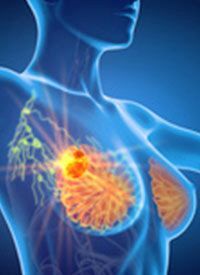Article
Neoadjuvant Pegylated Liposomal Doxorubicin Regimen Has Promising Efficacy in HER2+ Breast Cancer
Author(s):
The combination of pegylated liposomal doxorubicin, cyclophosphamide, trastuzumab, and pertuzumab elicited encouraging responses with acceptable safety when given as neoadjuvant treatment in patients with HER2-positive breast cancer.

The combination of pegylated liposomal doxorubicin (PLD), cyclophosphamide, trastuzumab (Herceptin), and pertuzumab (Perjeta) elicited encouraging responses with acceptable safety when given as neoadjuvant treatment in patients with HER2-positive breast cancer, according to data from a phase 2 trial (ChiCTR1900028433) presented at the 2022 ESMO Congress.
Among the 64 efficacy-evaluable patients who received the regimen, the pathological complete response (pCR) rate was 59.4%. Moreover, after the first 4 cycles of treatment, the objective response rate (ORR) was 68.8%.
“For neoadjuvant treatment of HER2-positive breast cancer, earlier use of HER2-targeting drugs may be helpful to shrink tumor as soon as possible,” lead study author Yaping Yang, MD, of the Breast Tumor Center at SunYat-Sen Memorial Hospital, Sun Yat-Sen University, in Guangzhou, China, and colleagues, wrote in a poster presentation of the data. “However, the combinational use of traditional anthracyclines and [trastuzumab] is generally avoided due to increased cardiotoxicity.”
PLD has been shown to result in less cardiotoxicity compared with doxorubicin; it has also been found to be safe when paired with trastuzumab in those with advanced breast cancer.
The single-arm, single-center phase 2 trial enrolled those with unilateral breast cancer with HER2 positivity and invasive disease. Patients were required to have a tumor size of at least 2 cm or positive lymph nodes. They also needed to have a left ventricular ejection fraction (LVEF) of at least 55%.
Once enrolled, all patients were administered 30 mg/m2 to 35 mg/m2 of PLD plus trastuzumab, pertuzumab, and cyclophosphamide every 3 weeks for 4 cycles, followed by trastuzumab, pertuzumab, and taxane chemotherapy every 3 weeks for 4 cycles.
The primary end point of the trial was pCR. Secondary end points comprised ORR after the first 4 cycles of treatment and safety.
As of the data cutoff date of July 25, 2022, 78 patients had enrolled to the trial, and pathological results were available for 64 of them. Among those with pathological results, 70.3% of patients were over 40 years of age, 59.4% were premenopausal, and 54.7% had hormone receptor (HR)–positive disease. Furthermore, 71.9% of patients had stage II disease, and 28.1% presented with stage III disease.
Tumor stage at baseline included T1 (4.7%), T2 (57.8%), T3 (35.9%), and T4 (1.6%). Lymph node stage consisted of N0 (26.6%), N1 (62.5%), N2 (6.3%), and N3 (4.7%).
Additional data showed that the regimen resulted in a pCR of 42.1% in patients aged 40 years or younger vs 66.7% in those over 40 years of age. Those with HR-positive disease experienced a pCR of 54.3% compared with 65.5% in those with negative disease. Among patients with T1/T2 disease, the pCR rate achieved with the regimen was 57.5% vs 62.5% in those with T3/T4 disease. Patients with negative lymph nodes experienced a pCR rate of 70.6% vs 55.3% in those with positive nodes. Lastly, patients with stage II disease achieved a pCR rate of 56.5% with the combination compared with 66.7% in those with stage III disease.
Regarding safety, 6 patients experienced asymptomatic LVEF declines of at least 10 percentage points from baseline; however, LVEFs for all patients remained above 55%.
The most common grade 3/4 adverse effects reported with the regimen included decreased white blood cell count (grade 3, 14.1%; grade 4, 7.8%), decreased lymphocyte count (20.3%; 1.6%), decreased neutrophil count (9.4%; 9.4%), increased alanine aminotransferase (6.3%; 0%), increased aspartate aminotransferase (4.7%; 1.6%), increased gamma glutamyltransferase (3.1%; 0%), oral mucositis (3.1%; 0%), hand-foot syndrome (3.1%; 0%), anemia (1.6%; 0%), decreased platelet count (1.6%; 0%), and febrile neutropenia (1.6%; 0%).
Reference
- Yang Y, Jin L, Rao N, et al. A phase II single-arm clinical study of neoadjuvant treatment with pegylated liposomal doxorubicin (PLD) plus cyclophosphamide (C) combined with trastuzumab (H) and pertuzumab (P) in HER2-positive (HER2+) breast cancer (BC). Ann Oncol. 2022;33(suppl 7):S624. doi:10.1016/j.annonc.2022.07.227









